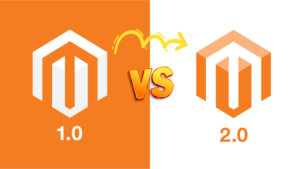Introduction:
Magento, an open-source e-commerce platform, has undergone a remarkable transformation from its humble beginnings with Magento 1 to the cutting-edge features of Magento 2. This evolution reflects a commitment to innovation and improvement, driven by the ever-changing landscape of e-commerce. In this comprehensive guide, we’ll take a deep dive into the journey of Magento, tracing its evolution from version 1 to Magento 2.

We’ll explore how each iteration has addressed the challenges and demands of online retail, ultimately enhancing performance, scalability, and user experience. Join us as we uncover the key milestones and advancements that have shaped this into the powerhouse it is today.
Magento 1: The Foundation
Magento 1: Pioneering the E-commerce Landscape

– Released in 2008, Magento 1 quickly gained traction as a leading eCommerce platform.
– Its comprehensive suite of features revolutionized online store management, offering solutions for catalog management, order processing, and customer accounts.
-
Key Features of Magento 1:
– Magento 1 introduced robust features such as customizable product catalogs, flexible pricing options, and advanced inventory management.
– Its modular architecture allowed for easy customization and integration with third-party extensions, enhancing functionality and scalability.
-
Challenges Faced by Magento 1:
– Despite its success, Magento 1 encountered challenges in performance optimization and scalability.
– As ecommerce grew more complex, Magento 1 struggled to keep pace with increasing demands for speed and efficiency.
-
Performance Optimization Efforts:
– The community actively worked on performance optimization initiatives to address issues such as slow page loading times and inefficient code execution.
– Various caching techniques and performance tuning strategies were implemented to improve website speed and responsiveness.
-
Scalability Limitations:
– As ecommerce businesses expanded, Magento 1 faced scalability limitations, particularly in handling high traffic volumes and large product catalogs.
– Scalability issues often led to performance bottlenecks and hindered the growth of online stores built on version 1.
-
End of Life for Magento 1:
– In June 2020, Magento officially ended support for Magento 1, marking the end of an era for the pioneering ecommerce platform.
– Merchants were encouraged to migrate to Magento 2 to benefit from improved performance, enhanced security, and ongoing support and updates.
-
Legacy and Impact:
– Despite its eventual retirement, Magento 1 left a lasting legacy in the ecommerce industry, paving the way for future innovations and advancements.
– Many ecommerce businesses thrived on version 1, leveraging its powerful features and flexibility to create successful online stores.
By understanding the journey of Magento 1, Gain insights into the evolution of ecommerce platforms and the ongoing quest for performance, scalability, and innovation.
The Need for Magento 2: Addressing Limitations and Embracing Innovation
Recognizing the limitations of Magento 1, the development team embarked on creating Magento 2, aiming to address existing issues and introduce innovative features to meet the evolving needs of ecommerce businesses. With the ecommerce landscape rapidly evolving, there was a growing demand for a platform that could deliver enhanced performance, scalability, and user experience. version 2 was designed to meet these requirements and provide merchants with a modern and feature-rich ecommerce solution.
Key Features and Improvements

Enhanced Performance:
Magento 2 introduced significant performance improvements, including faster page loading times, optimized code structure, and improved database scalability. These enhancements resulted in a smoother and more responsive shopping experience for users, leading to higher conversion rates and customer satisfaction.
Mobile Responsiveness:
With the rise of mobile commerce, Magento 2 prioritized mobile responsiveness, ensuring that online stores were fully optimized for mobile devices. The platform offered responsive design themes and touch-friendly interfaces, allowing merchants to reach customers across various devices and screen sizes.
Streamlined Checkout Process:
Magento 2 revamped the checkout process, simplifying and streamlining the steps required to complete a purchase. The platform introduced a one-page checkout option, reducing cart abandonment rates and improving conversion rates for ecommerce stores.
Advanced Security Features: Security was a top priority in version 2, with the platform incorporating advanced security features to protect merchants and their customers from potential threats. Built-in security enhancements, such as improved password hashing algorithms and secure payment gateways, helped safeguard sensitive data and prevent security breaches.
Modular Architecture: Magento 2 adopted a modular architecture, allowing for easier customization and scalability. The platform embraced modern development practices, such as dependency injection and component-based design, making it more flexible and adaptable to changing business requirements.
Seamless Integration: Magento 2 offered seamless integration with third-party systems and extensions, enabling merchants to enhance their online stores with additional features and functionalities. The platform supported integrations with popular payment gateways, shipping providers, and marketing tools, empowering merchants to create tailored ecommerce solutions.
Ongoing Support and Updates: Unlike Magento 1, which reached its end of life, Magento 2 continues to receive regular updates and support from the Magento community and development team. This ensures that merchants can benefit from ongoing improvements, security patches, and compatibility updates, keeping their online stores up-to-date and secure.
Magento 2 addressed the shortcomings of its predecessor while embracing innovation and modernization. With its enhanced performance, mobile responsiveness, streamlined checkout process, advanced security features, modular architecture, seamless integration capabilities, and ongoing support, Magento 2 emerged as a leading ecommerce platform for businesses of all sizes.
Key Improvements in Magento 2:

Magento 2 brought significant enhancements over its predecessor, including:
Performance Optimization:
Improved Loading Speed: version 2 introduced full-page caching and optimized code structure, resulting in faster loading times for web pages.
Enhanced Scalability: With support for multiple databases and improved indexing, version 2 can handle larger product catalogs and higher traffic volumes more efficiently.
User Experience Enhancements:
Mobile Responsiveness: version 2 offers a mobile-friendly interface and responsive design out-of-the-box, catering to the growing number of mobile shoppers.
Streamlined Checkout Process: The checkout process in version 2 is simplified and optimized, reducing cart abandonment rates and improving conversion rates.
Developer-Friendly Features:
Modular Architecture: version 2’s modular architecture allows developers to customize and extend functionality more easily, facilitating faster development and deployment of custom features.
Enhanced Admin Panel: The revamped admin panel in version 2 provides a more intuitive and user-friendly interface, making it easier for merchants to manage their online stores.
Migration to Magento 2:
Migration to Magento 2: Embracing Innovation and Future-Proofing Your Ecommerce Store
While version 1 continues to be supported, merchants are encouraged to migrate to version 2 to leverage its advanced features and long-term support. The migration process involves several crucial steps to ensure a smooth transition and unlock the full potential of Magento 2 for your ecommerce store.
Data Migration: One of the primary tasks during the migration process is transferring your existing data from version 1 to version 2. This includes product catalogs, customer information, order history, and other essential data. Data migration tools and scripts are available to simplify this process and minimize downtime during the transition.
Theme Customization: Magento 2 introduces a new theme structure and layout system, requiring merchants to customize or develop new themes compatible with the platform. While version 1 themes may not be directly compatible with version 2, developers can adapt existing themes or create new ones tailored to the requirements of Magento 2.
Extension Compatibility Testing: Extensions and third-party integrations play a crucial role in extending the functionality of your ecommerce store. However, not all version 1 extensions are compatible with Magento 2. Before migrating, merchants need to assess the compatibility of their existing extensions and identify alternatives or updates for Magento 2 compatibility.
Code Migration and Custom Development: Along with data migration, merchants may need to migrate custom code, modules, and integrations from version 1 to version 2. This involves reviewing and updating code to ensure compatibility with the latest version of Magento and adhering to best practices and coding standards.
Performance Optimization: With Magento 2’s focus on performance and scalability, merchants have the opportunity to optimize their ecommerce stores for better speed and efficiency. This may involve implementing caching mechanisms, optimizing images and media files, and fine-tuning server configurations to enhance overall performance.
Training and Testing: As with any major platform migration, thorough testing and training are essential to ensure a successful transition. Merchants should conduct comprehensive testing to identify any issues or discrepancies before going live with the Magento 2 store. Additionally, providing training to staff members on the new platform’s features and functionalities can help ensure a smooth transition and minimize disruptions to day-to-day operations.
Post-Migration Support and Optimization: Once the migration to Magento 2 is complete, ongoing support and optimization are crucial for maintaining the health and performance of your ecommerce store. Regular updates, security patches, and performance monitoring can help address any issues and keep your Magento 2 store running smoothly.
Migrating to Magento 2 offers merchants the opportunity to embrace innovation, unlock advanced features, and future-proof their ecommerce stores. By following a structured migration process and leveraging the capabilities of version 2, merchants can enhance their online presence, improve customer experiences, and drive business growth. As experienced Magento developers in India, we understand the importance of a seamless migration process. Our outsourced Magento developers offer affordable Magento development services, ensuring that your transition to Magento 2 is smooth and cost-effective. By partnering with a reputable Magento development agency, you can take advantage of the powerful features of version 2 and elevate your ecommerce business to new heights.
Conclusion:
The evolution of Magento from version 1 to version 2 represents a significant milestone in the realm of ecommerce. With its enhanced performance, scalability, and user experience, version 2 sets the stage for the future of online retail, empowering merchants to create compelling and successful ecommerce stores.
Wrapping Up:
At Zonvoir, we specialize in Magento website development, offering expert services to help businesses harness the power of Magento 2 for their ecommerce needs. As one of the best development agencies in India, our team of Magento developers in India is dedicated to providing top-notch Magento development services at affordable rates through outsourcing. Whether you need assistance with Magento CMS customization, theme development, or extension integration, our experienced team has the expertise to deliver exceptional results. Contact us today to embark on your journey to Magento success with a trusted Magento development agency.





Leave a Reply